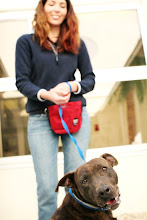Every now and then our dogs do something they shouldn't. (Gasp!) I know it's hard to believe, but it happens. So what do we do?
Many people would answer that question with "punish them". But HOW to punish a dog properly is too often left un-answered.
Punishment can be divided into two distinct categories, positive and negative. Don't think of positive as good and negative as bad, think of them as plus and minus signs.
So, positive punishment is ADDING something to a dogs environment that decreases the likelihood of an undesired behavior reoccurring in the future. (Leash corrections, verbal reprimands, squirt bottles, penny cans etc...)
Negative punishment is REMOVING something from a dogs environment that decreases the likelihood of an undesired behavior reoccurring in the future. (Removing your attention/turning your back when a dog jumps on you.)
Positive punishment is not recommended in the forms of hitting, yelling or causing the dog any pain or severe discomfort. And NEVER use this form with fearful or aggressive dogs.
I use only Positive Reinforcement to train with negative punishment a distant second. (For more information on positive reinforcement see my earlier blog on the subject...) I do not use positive punishment.
Remember to act quickly! If you punish a dog too late, you may actually be punishing them for ceasing the unwanted behavior! You can only correct a dog in the act, never after the fact. Always re-direct your dog into an acceptable behavior. We spend way too much time telling our poor doggies what NOT to do, and not nearly enough time telling them what they CAN do!
To be effective, punishment must be: sufficiently aversive, immediate, delivered with EVERY occurrence of the undesired behavior and followed by positively reinforcing a desired behavior.
Good luck and happy training!
Subscribe to:
Post Comments (Atom)





You are so correct about altering our pets bad behaviors - especially the consistancy part. I'm not sure I even like to use the word punishment but rather "correction" or as you stated "re-direction."
ReplyDelete